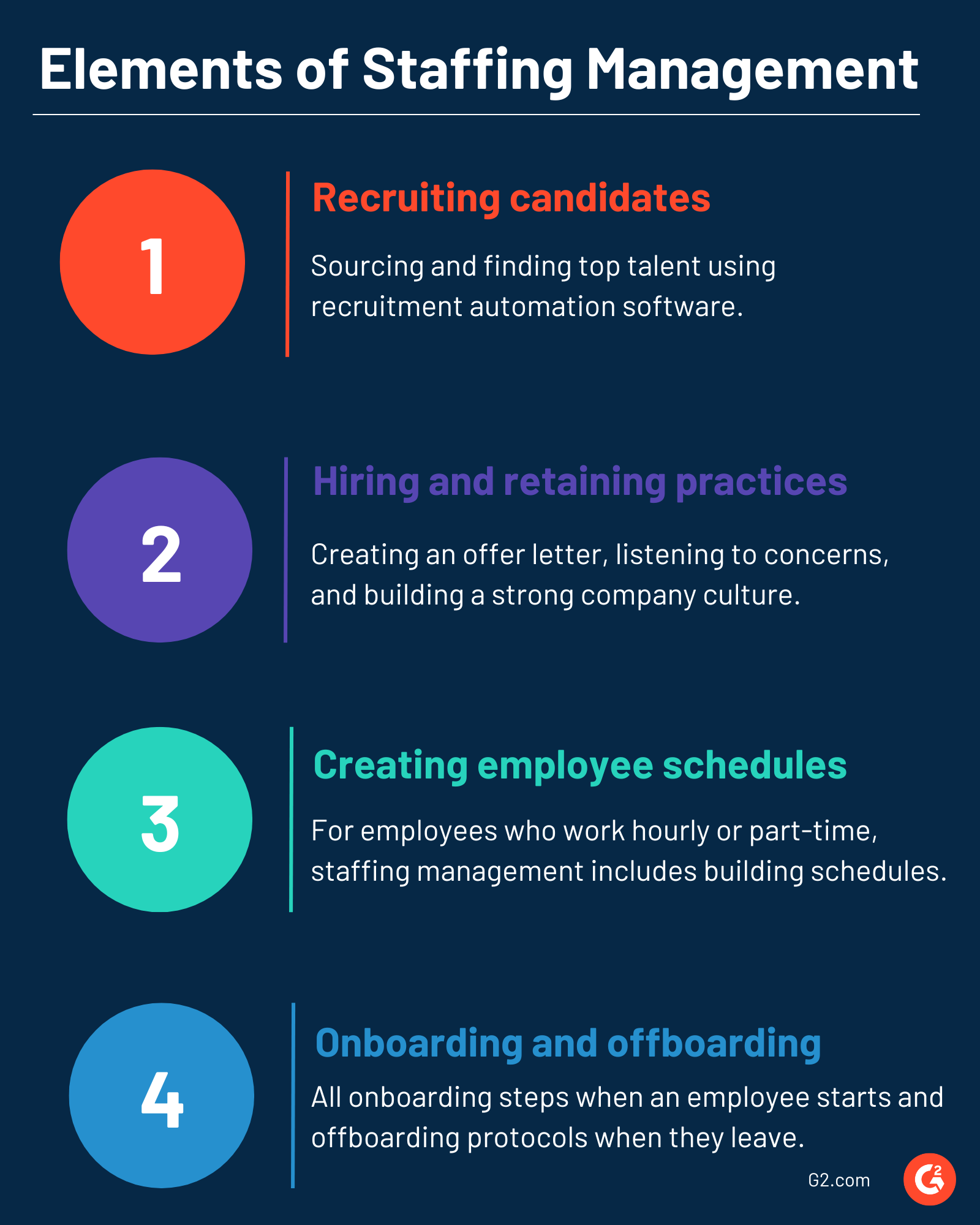What is staffing management?
Staffing management consists of the processes, tactics, and strategies that are needed to identify, recruit, and retain employees within an organization. This includes everything from sourcing candidates, recruiting talent, onboarding new hires, and retaining employees.
Staffing management is essentially the plan businesses put in place to identify and acquire the talent it needs across all departments. Having staffing management procedures in place will address all workforce throughout the organization, and when done correctly using workforce management software, assist in boosting productivity and the likelihood that projects are completed and deadlines are met.
Types of staffing management
Depending on the size of an organization, its industry, and its specific needs, it’ll utilize one of these two types of staffing management techniques.
- Direct hire staffing: Full-time positions with benefits that are typically a long-term need of the organization. This employee goes on a company’s payroll.
- Contract staffing: Usually a temporary need where an employee is hired for a set amount of time. This employee is usually paid an hourly rate.
Benefits of staffing management
If an organization doesn’t currently have a staffing management strategy or protocol in place, here are some reasons it should instate one.
- Quickly fill open roles: If a role within an organization opens up unexpectedly, utilizing staffing management software can ensure that it doesn’t stay unfilled for an exorbitant amount of time by using recruitment and candidate sourcing strategies to fill it quickly.
- Find the right person for the job: When an organization takes the time to invest in staffing management, they can utilize fully built-out talent pools as well as successful recruitment strategies to ensure that the candidate that joins an organization is the right fit and has the skills necessary to be successful.
- Faster company growth: When the above two benefits come together successfully, an organization can grow and scale at a faster pace, which can increase the likelihood of goals being accomplished across all departments. It can also mean hiring more interdepartmental team members to help reach organization-wide goals.
- Cost savings: Staffing management can result in cost savings for companies. The likelihood of making a bad hire decreases while employees who are truly the best fit for the role increases.
- Improve job satisfaction, morale, and retention: When the right training, promotion, and compensation occur from utilizing staffing management, this also results in a boost in employee motivation, morale, and retention.
Basic elements of staffing management
To ensure that the human resources department understands the ins and outs of staffing management.

Below are the basic elements that it encompasses.
- Sourcing and recruiting candidates: Effective staff management starts with being able to source and find top talent using recruitment automation software. No matter what recruitment marketing strategy is needed, it’s the first step in staffing management.
- Hiring and retention practices: When the right candidate is found, staffing management encompasses everything within the hiring process. This includes creating an offer letter and anything preliminary before the candidate’s first day. It also includes taking the necessary steps to retain employees by listening to their concerns and building a strong company culture.
- Scheduling employee schedules: For employees who work hourly or are part-time workers, a part of staffing management is knowing how to build out schedules.
- Onboarding and offboarding protocols: Once an employee starts, this also encompasses all of the necessary onboarding procedures, which can be streamlined when onboarding software is in use. When an employee decides it’s time to part ways with a company, staffing management handles offboarding protocols to ensure a smooth transition.
Staffing management best practices
To ensure staffing management at your organization is done correctly, follow these best practices as you develop a plan of action.
- Identify the staffing need: This encompasses the needs and goals of the department with the open role, the hard and soft skills a candidate will need, and whether to go the direct or contract hire route.
- Create a timeline: This will allow you to know how fast a role needs to be filled, its exact urgency, and, if contracted, how long the employee will be at the company.
- Establish a budget: Before you can make a hire, you need to know how much it will cost to do the hiring that is necessary, if there’s room within the budget, and how much both a direct and contract hire could cost.
- Consider talent acquisition strategies: As use recruiting automation to look for staff to join your team, you could either seek out active jobseekers who are already interested in your company, dip into your talent pool, or pinpoint passive candidates who you believe would be a good fit for the role.
- Develop an onboarding program: Your organization needs to have a comprehensive onboarding program that sets up new employees on the right foot. A new employee, whether they're contract or direct, needs to have everything they need on day one of the job.
- Iron out training materials and procedural documentation: Training is not a one-size-fits-all method, and it shouldn’t stop once the onboarding phase has concluded. Set employees up for success with long-term training materials and documents on how to be as efficient as possible.

Mara Calvello
Mara Calvello is a Content and Communications Manager at G2. She received her Bachelor of Arts degree from Elmhurst College (now Elmhurst University). Mara writes content highlighting G2 newsroom events and customer marketing case studies, while also focusing on social media and communications for G2. She previously wrote content to support our G2 Tea newsletter, as well as categories on artificial intelligence, natural language understanding (NLU), AI code generation, synthetic data, and more. In her spare time, she's out exploring with her rescue dog Zeke or enjoying a good book.








